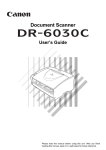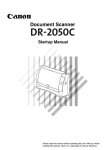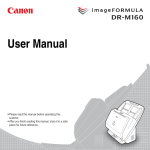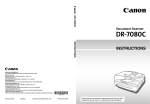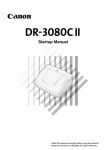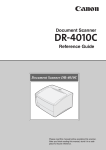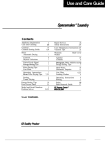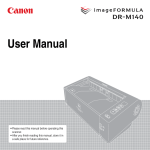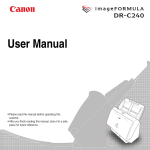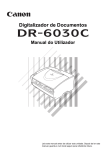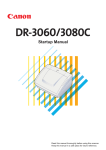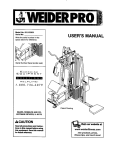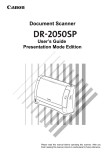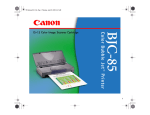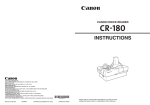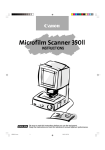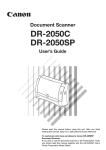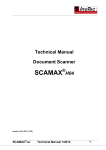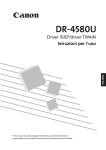Download Canon DR-5010C Owner's Manual
Transcript
Document Scanner
Startup Manual
Please read this manual before operating this unit. After you finish
reading this manual, store it in a safe place for future reference.
International ENERGY STAR® Office Equipment Program
As an ENERGY STAR® Partner, Canon Electronics Inc., has determined that this machine
meets the ENERGY STAR® Program guidelines for energy efficiency.
The International ENERGY STAR® Office Equipment Program is an international program
that promotes energy saving through the use of computers and other office equipment.
The program backs the development and dissemination of products with functions that
effectively reduce energy consumption. It is an open system in which business
proprietors can participate voluntarily. The targeted products are office equipment, such
as computers, monitors, printers, fax, machine, copiers, and scanners. The standards and
logos are uniform among participating nations.
Trademarks
• Canon and the Canon logo are trademark of Canon Inc.
• Microsoft and Windows are registered trademarks of Microsoft Corporation in the United States and other countries.
• ISIS is a trademark of Pixel Translations, a division of Captiva Software Corporation, in the United States.
• Intel and Pentium are registered trademarks of Intel Corporation.
• ENERGY STAR® is a U.S. registered mark.
• Adobe is the registered trademark of Adobe Systems Incorporated in the United States and/or other countries.
• Adaptec is registered trademark of Adaptec Inc.
• Other product and company names here in may be the trademarks of their respective owners.
Copyright
Copyright 2005 by CANON ELECTRONICS INC. All rights reserved. No part of this publication may be
reproduced or transmitted, in any form or by any means, electronic or mechanical, including photocopying
and recording, or by any information storage or retrieval system without the prior written permission of
CANON ELECTRONICS INC.
Disclaimers
The information in this document is subject to change without notice.
CANON ELECTRONICS INC. MAKES NO WARRANTY OF ANY KIND WITH REGARD TO THIS
MATERIAL, EITHER EXPRESS OR IMPLIED, EXPECT AS PROVIDED HERE IN, INCLUDING WITHOUT
LIMITATION, THERE OF, WARRANTIES AS TO MARKETABILITY, MERCHANTABILITY, FITNESS FOR
A PARTICULAR PURPOSE OF USE OR AGAINST INFRINGEMENT OF ANY PATENT. CANON
ELECTRONICS INC. SHALL NOT BE LIABLE FOR ANY DIRECT, INCIDENTAL, OR CONSEQUENTIAL
DAMAGES OF ANY NATURE, OR LOSSES OR EXPENSES RESULTING FROM THE USE OF THIS
MATERIAL.
READ CAREFULLY BEFORE OPENING THE SEALED DISK PACKAGE
CANON SOFTWARE LICENSE AGREEMENT
IMPORTANT-READ THIS AGREEMENT BEFORE OPENING THE SEALED DISK PACKAGE! BY OPENING
THE SEALED DISK PACKAGE, YOU ARE DEEMED TO AGREE TO BE BOUND BY THIS AGREEMENT.
This legal document is a license agreement between you and Canon Electronics Inc. ("Canon"). BY OPENING THE SEALED DISK
PACKAGE, YOU ARE DEEMED TO AGREE TO BE BOUND BY THE TERMS OF THIS AGREEMENT. IF YOU DO NOT AGREE TO THE
TERMS OF THIS AGREEMENT, DO NOT OPEN THE SEALED DISK PACKAGE AND PROMPTLY RETURN THE CANON SCANNER,
THE DISK PACKAGE CONTAINING SCANNER DRIVER SOFTWARE PROGRAMS AND/OR SCANNER UTILITY SOFTWARE
PROGRAM PROPRIETARY TO CANON OR ITS LICENSOR (THE "SOFTWARE") AND THE ACCOMPANYING DOCUMENTATION
AND OTHER ITEMS TO THE PLACE WHERE YOU OBTAINED THEM FOR A REFUND BEFORE THEY ARE USED OR OPENED OR
UNPACKED.
In consideration of the right to use the SOFTWARE, you agree to abide by the terms and conditions of this Agreement.
1. GRANT OF LICENSE: Canon grants you the personal, non-exclusive right to use the SOFTWARE only on a single computer. You
may physically transfer the SOFTWARE from one computer to another provided that the SOFTWARE is used on only one computer at any time.
You shall not assign, sublicense, sell, rent, lease, loan, convey or transfer to any third party, or send or bring the SOFTWARE out of the
country where you originally obtain it to other countries without required authorization of applicable governments, or copy, duplicate, translate or
convert to another programming language the SOFTWARE or accompanying documentation, except as expressly provided herein.
Except as expressly permitted under the applicable law, you shall not alter, modify, disassemble, decompile or otherwise reverse engineer
the SOFTWARE or accompanying documentation and you also shall not have any third party do so.
2. BACK-UP COPY: You may make one copy of the SOFTWARE solely for a back-up purpose or copy the SOFTWARE onto the
permanent storage device (e.g. a hard disk) of your computer and retain the original for a back-up purpose. Except as expressly permitted under the
applicable law, any other copying of the SOFTWARE is a violation of this Agreement. You must reproduce and include the copyright notice on the
back-up copy.
3. SUPPORT AND UPDATE: Canon, Canon's affiliate, their distributor or dealer is not responsible for maintaining or helping you to
use the SOFTWARE. No updates, fixes or support will be made available for the SOFTWARE.
4. LIMITED WARRANTY AND DISCLAIMER OF INDEMNITY: Canon, Canon's affiliate, their distributor or dealer will not
guarantee uninterrupted service, or absence or correction of errors. Therefore, the SOFTWARE is licensed on an "AS IS" basis without warranty of
any kind. The diskette on which the SOFTWARE is recorded is warranted against defective material or workmanship under normal use for a period
of ninety (90) days from the date you purchased the same as evidenced by a receipt or otherwise. The limited warranty does not apply if the failure
of the diskette resulted from accident, abuse or misapplication of the SOFTWARE and shall not extend to anyone other than the original user of the
SOFTWARE.
CANON, CANON'S AFFILIATE, THEIR DISTRIBUTOR OR DEALER DISCLAIMS ALL IMPLIED WARRANTIES, INCLUDING
ANY WARRANTY OF MERCHANTABILITY OR FITNESS FOR A PARTICULAR PURPOSE, WITH RESPECT TO THE SOFTWARE OR
ACCOMPANYING DOCUMENTATION.
NEITHER CANON, CANON'S AFFILIATE, THEIR DISTRIBUTOR NOR DEALER IS LIABLE FOR ANY LOSS OR DAMAGE
INCLUDING CONSEQUENTIAL OR INCIDENTAL LOSS OR DAMAGE SUCH AS LOSS OF PROFITS, EXPENSE OR INCONVENIENCE,
WHATSOEVER CAUSED BY OR ARISING OUT OF THE SOFTWARE, ACCOMPANYING DOCUMENTATION OR THE USE THEREOF.
CANON, CANON'S AFFILIATE, THEIR DISTRIBUTOR OR DEALER SHALL HAVE NO OBLIGATION TO INDEMNIFY YOU
AGAINST ANY CLAIM OR SUIT BROUGHT BY A THIRD PARTY ALLEGING THAT THE SOFTWARE, ACCOMPANYING
DOCUMENTATION OR THE USE THEREOF INFRINGES ANY INTELLECTUAL PROPERTY OF SUCH THIRD PARTY.
THE ABOVE IS CANON'S ENTIRE LIABILITY AND YOUR EXCLUSIVE REMEDY IN CONNECTION WITH THE SOFTWARE
AND ACCOMPANYING DOCUMENTATION.
5. TERM: This Agreement is effective upon opening the sealed disk package and remains in effect until terminated. You may terminate
this Agreement by destroying the SOFTWARE and any copy thereof. This Agreement will also terminate if you fail to comply with any of the
terms of this Agreement. In addition to Canon enforcing its respective legal rights, you must then promptly destroy the SOFTWARE and any copy
thereof.
6. U.S. GOVERNMENT RESTRICTED RIGHTS NOTICE: The SOFTWARE is provided with RESTRICTED RIGHTS. Use,
duplication or disclosure is subject to restrictions as set forth in either subparagraph (c) (1) (ii) of the Rights in Technical Data and Computer
Software clause at DFARs 252.227-7013 or subparagraph (c) (1) and (2) of the Commercial Computer Software Restricted Rights Clause at FAR
52.227-19, as applicable.
7. SEVERABILITY: In the event that provision of this Agreement is declared or found to be illegal by any court or tribunal of
competent jurisdiction, such provision shall be null and void with respect to the jurisdiction of that court or tribunal and all the remaining provisions
of this Agreement shall remain in full force and effect.
8. ACKNOWLEDGEMENT: BY OPENING THE SEALED DISK PACKAGE, YOU ACKNOWLEDGE THAT YOU HAVE READ
THIS AGREEMENT, UNDERSTOOD IT, AND AGREE TO BE BOUND BY ITS TERMS AND CONDITIONS. YOU ALSO AGREE THAT
THIS AGREEMENT IS THE COMPLETE AND EXCLUSIVE STATEMENT OF AGREEMENT BETWEEN YOU AND CANON
CONCERNING THE SUBJECT MATTER HEREOF AND SUPERSEDES ALL PROPOSALS OR PRIOR AGREEMENTS, VERBAL OR
WRITTEN, AND ANY OTHER COMMUNICATIONS BETWEEN YOU AND CANON RELATING TO THE SUBJECT MATTER HEREOF.
NO AMENDMENT TO THIS AGREEMENT SHALL BE EFFECTIVE UNLESS SIGNED BY A DULY AUTHORIZED REPRESENTATIVE
OF CANON.
Should you have any questions concerning this Agreement, or if you desire to contact Canon for any reason, please write to Canon's local affiliate.
INTRODUCTION
Thank you for purchasing the Canon DR-5010C scanner. Please read this
manual thoroughly before using the machine to familiarize yourself with it's
capabilities, and to make the most of its many functions. After reading this
manual, store it in a safe place for future reference.
Manuals for the Scanner
The DR-5010C scanner has a Startup Manual (this manual) and online help.
Please refer to the Startup Manual regarding the handling of the scanner, such
as installation of software and setting up the scanner. The online help explains
how to use the ISIS/TWAIN driver and the enclosed software,
CapturePerfect.
Document Scanner
Document Scanner
Startup Manual
Startup Manual
Please read this manual before operating this unit. After you finish
Reading this manual, store it in a safe place for future reference.
Startup Manual
Explains how to set up the scanner,
make connections, install software, and
other procedures.
Be sure to read it before using the
scanner.
ISIS/TWAIN Driver Help
Explains how to use the
ISIS/TWAIN driver.
2
INTRODUCTION
Installing the
Scanner (See p. 16.)
Installation Procedure
(See p. 18.)
Installing the
ISIS/TWAIN Driver
(See p. 28.)
Installing CapturePerfect
(See p. 31.)
Please read this manual before operating this unit. After you finish
Reading this manual, store it in a safe place for future reference.
CapturePerfect Help
Explains how to use
CapturePerfect.
Conventions
This manual uses the following symbols and indications.
Before you start reading this manual, read the following and familiarize
yourself with their meanings.
WARNING
Indicates a warning concerning operations that may lead to death
or injury to persons if not performed correctly. In order to use the
machine safely, always pay attention to these warnings.
CAUTION
Indicates a caution concerning operations that may lead to injury
to persons, or damage to property if not performed correctly. In
order to use the machine safely, always pay attention to these
cautions.
IMPORTANT
Indicates operational requirements and restrictions. Be sure to read these items
carefully in order to operate the machine correctly, and to avoid damage to the
machine.
Note
Indicates a clarification of an operation, or contains additional explanations
for a procedure. Reading these notes is highly recommended.
INTRODUCTION
3
Contents
INTRODUCTION ....................................................................................................... 2
Manuals for the Scanner ................................................................................................ 2
Conventions ................................................................................................................ 3
Before Using the Scanner ...................................................................................... 5
Safe Operation ............................................................................................................... 5
Installation Location ....................................................................................................... 5
Power ............................................................................................................................. 6
Moving the Scanner ....................................................................................................... 6
Normal Handling ............................................................................................................ 7
Disposal ......................................................................................................................... 8
Features of the DR-5010C .......................................................................................... 9
Checking the Packing List ......................................................................................... 11
Removing the Protective Packing Matarials ................................................................ 12
Names and Functions of Parts ..................................................................................... 14
Installing the Scanner ........................................................................................... 16
Installation Requirements .......................................................................................... 16
Installation Procedure ............................................................................................... 18
Interface Cards .......................................................................................................... 19
SCSI Cards .................................................................................................................. 19
USB 2.0 Interface Card ................................................................................................ 19
Connecting the Scanner to Your PC .......................................................................... 21
Connecting via SCSI ................................................................................................... 21
Connecting USB Interface ........................................................................................... 23
Connecting the Power Cord ...................................................................................... 24
Turning the Power ON/OFF ....................................................................................... 25
Turning the Power ON ................................................................................................. 25
Recognizing the Scanner ............................................................................................ 25
Turning the Power OFF ................................................................................................ 27
Installing the Software .......................................................................................... 28
Installing the ISIS/TWAIN Driver ............................................................................... 28
Installing CapturePerfect ........................................................................................... 31
Uninstalling Software ................................................................................................ 32
Using the Software ................................................................................................ 35
Using the ISIS/TWAIN Driver .................................................................................... 35
Using CapturePerfect ................................................................................................ 36
Starting CapturePerfect ............................................................................................... 36
Starting CapturePerfect with the Event Function ...................................................... 39
Confirming Scanner Event ........................................................................................... 39
Using the Scanner ................................................................................................. 42
Documents ................................................................................................................ 42
Setting Up the Document Feed Tray and the Document Eject Tray ........................... 44
Document Eject Tray ................................................................................................. 45
Installing the Document Eject Guide ......................................................................... 47
Placing a Document for Scanning ............................................................................. 49
How to Feed with the Page Separation Mode ............................................................. 49
How to Feed with the Bypass Mode ............................................................................ 52
Patch Code Sheets ................................................................................................... 54
About Patch Code Sheets ........................................................................................... 54
Functions of Patch Code Sheets ................................................................................. 55
Using Patch Code Sheets ............................................................................................ 55
Effective Area for Detecting Patch Code Patterns ....................................................... 56
Clearing a Paper Jam ................................................................................................ 57
Other Functions ......................................................................................................... 60
Regular Maintenance ............................................................................................ 61
Cleaning the Scanner .................................................................................................. 61
Cleaning inside the Scanner ........................................................................................ 61
Cleaning the Sensor Glass and the Rollers ................................................................. 62
Cleaning the Shading Boards ...................................................................................... 65
Removing and Attaching the Rollers ......................................................................... 67
Roller Replacement Message ..................................................................................... 67
Resetting the Counter .................................................................................................. 68
Removing and Attaching the Pickup Roller ................................................................. 70
Removing and Attaching the Feed Roller .................................................................... 73
Removing and Attaching the Retard Roller ................................................................. 77
Troubleshooting .................................................................................................... 81
Specifications ........................................................................................................ 87
Index ....................................................................................................................... 90
4
Contents
Before Using the Scanner
Safe Operation
In order to ensure safe operation, be certain to read the cautions described
below.
Installation Location
17.7" (450 mm)
when the
Document Feed
Tray and
Document Feed
Tray Extension
are closed
At least 3.9" (100 mm)
when Eject Tray is empty
29.5" (750 mm) when
the Document Feed
Tray and Document
Feed Tray Extension
are open
The performance of this scanner is affected by the environment in which it is
installed. Make sure that the location where the scanner is installed meets the
following environmental requirements:
• Provide adequate space around the scanner (as indicated in the above
diagram) for operation, maintenance, and ventilation purposes.
• Provide adequate space behind the scanner in order to eject scanned
documents to the back of the scanner. (See “Document Eject Tray,” on p. 45. )
• Avoid locations exposed to direct sunlight. If the scanner must be placed in
such a spot, hang a heavy curtain or similar object to shade the scanner.
• Avoid dusty locations. Dust can get inside of the scanner and cause
problems.
• Avoid warm or humid locations, such as in the vicinity of a water faucet,
water heater, or humidifier, and avoid locations where the fumes from
ammonia, paint thinner, or other volatile chemicals may be present.
• Avoid unstable surfaces and locations subject to vibration.
Before Using the Scanner
5
• Avoid locations that are subject to rapid temperature changes. Condensation
inside of the scanner can result in inferior image quality. Use this scanner
under the following environmental conditions:
Temperature: 10˚C to 32.5˚C (50˚F to 90.5˚F)
Humidity:
20% to 80% RH
• Avoid locating the scanner near equipment that generates electromagnetic
fields, including speakers, televisions, and radios.
Power
• Connect only to a power outlet of the rated voltage and power supply
frequency. (Either 120 V, 60 Hz or 220-240 V, 50/60 Hz depending on
your region.)
• Do not connect this scanner to a power outlet that is shared with other
equipment. When using an extension cord, make sure that the extension
cord is rated for the current requirements of the scanner.
• Do not place other objects on the power cord. Do not step on the power
cord.
• Do not bundle the power cord or wrap the power cord around an object,
such as a table leg.
• Do not pull on the power cord. Always grasp the plug when unplugging the
power cord.
• Do not place other objects around the outlet.
• If you have any questions concerning your local power supply, contact your
local authorized Canon dealer or your local power company.
Moving the Scanner
• To avoid dropping or damaging the scanner, always carry it with two hands.
The scanner weighs approximately 23 lb (10.2 kg).
• Make sure to disconnect the interface cable and power cord. If the scanner
is transported with these items plugged in, the plugs and connectors may be
damaged due to physical shock or concussion.
6
Before Using the Scanner
Normal Handling
WARNING
To avoid fire and electric shock, always observe the following
warnings when using this scanner.
• Do not place flammable chemicals, such as alcohol or paint thinner, near the
scanner.
• Do not cut, damage, or modify the power cord. Do not place heavy objects
on the power cord, do not pull on the power cord, and do not bend the
power cord sharply.
• Do not plug in or unplug the power cord with wet hands.
• Do not use multioutlet adapters to connect multiple devices to one outlet.
• Do not tie up or bundle the power cord. Push the plug in as far as it will go
when plugging in the power cord.
• Only use the power cord that was provided with this scanner.
• Do not attempt to disassemble or modify this scanner.
• Do not use flammable sprays near this scanner.
• Always turn the scanner OFF and unplug the power cord before cleaning
this scanner.
• To clean this scanner, dampen a cloth in a mild detergent solution and then
wring the cloth out thoroughly. Do not use flammable liquids to clean the
scanner, including alcohol, benzene, or paint thinner.
• If the scanner ever makes a strange noise, emits smoke or a strange odor,
becomes hot, or if the scanner does not operate at all even though the power
is ON, immediately turn the scanner OFF and unplug the power cord.
Contact your local authorized Canon dealer or service representative to have
the scanner serviced.
• Do not drop, kick, or otherwise strike the scanner. If the scanner does
somehow become damaged, immediately turn the scanner OFF and unplug
the power cord. Contact your local authorized Canon dealer or service
representative to have the scanner serviced.
• Always turn the scanner OFF and unplug the power cord before moving the
scanner.
• Notice to Cardiac Pacemaker Users
This product generates a weak magnetic field. If you use a cardiac
pacemaker, move away from product in the event that you notice any
unusual symptoms. Also, please consult a cardiologist.
Before Using the Scanner
7
CAUTION
• Do not set the scanner up on a wobbly platform, a sloped surface, or any
other type of unstable location. Do not set up the scanner in a location that
is subject to vibration. The scanner could injure someone if it falls or tips
over.
• Do not block the Ventilation Openings. Doing so could cause the scanner to
overheat, creating a risk of fire.
• Do not place paper clips, staples, necklaces, or any other metallic objects on
top of the scanner. Liquids or small metallic objects that get inside of the
scanner create a risk of fire or electrical shock. If such foreign matter does
get inside of the scanner, unplug the power cord immediately, and then
contact your local authorized Canon dealer or service representative for
assistance.
• Do not set up the scanner in a dusty or humid location. Doing so creates a
risk of fire or electrical shock.
• Do not place objects on top of the scanner. The object could injure someone
if it falls or tips over.
• To prevent any risk of fire or electrical shock, be sure that the power source
meets the power requirements of the scanner.
• When unplugging the power cord, always grasp the plug. Pulling on the
cord itself could expose or break the wires in the power cord, damaging the
cord and creating a risk of fire or electrical shock.
• In order to allow you to easily unplug the power cord at any time, do not
place other objects around the power outlet. Such obstacles could prevent
you from unplugging the power cord quickly in an emergency.
• Do not spill liquids or flammable chemicals (such as alcohol, paint thinner,
or benzene) on the scanner. Doing so creates a risk of fire or electrical
shock.
• If the scanner will not be used for an extended period of time, unplug the
power cord for safety’s sake.
• When operating this scanner, avoid wearing loose fitting clothing, dangling
jewelry, or other material that could get pulled into the scanner. Injury could
result. Be especially careful if you are wearing a necktie or have long hair.
In the event that some article or clothing does get caught in the scanner, turn
the power OFF immediately.
• Be careful when placing paper in the scanner and when removing jammed
paper. It is possible to cut your hand on the edge of a sheet of paper.
Disposal
• When disposing of this scanner, be sure to follow all local ordinances and
laws or consult with the retailer who sold you the scanner.
8
Before Using the Scanner
Features of the DR-5010C
The main features of the DR-5010C scanner are listed below.
■ Fast Document Feeding
The scanner can scan a maximum of 50 documents per minute in a range of
sizes from business cards to 11.6" x 17"/A3 size. (Scanning conditions:
Black and white, LTR/A4 size portrait, two sided, 200 dpi)
■ Compact Size
The scanner is extremely compact, with measurements of 15.6" x 12.3" x
7.5" (398.4 mm x 312 mm x 191.4 mm) (W x D x H).
■ SCSI III/USB 2.0 Interface Supported
The scanner is equipped with both SCSI III and Hi-Speed USB 2.0
interfaces for connecting to a personal computer.
■ Color/Grayscale Support
Documents can be scanned in 24-bit color or 256-level grayscale.
■ Supports a Variety of Scanning Modes
The scanner supports the following scanning modes, depending on the
document type:
• Single-sided/double-sided mode
• Single sheet/dual feeding path
■ U-Turn Path
Documents are fed and ejected, from the front of the scanner.
(See “Document Eject Tray,” on p. 45.)
■ Straight Path
Documents are ejected to the back of the scanner. Note, the ejected
documents are stacked in reverse order to how they were fed. (See
“Document Eject Tray,” on p. 45.)
■ Paper Size Detection
The scanner automatically detects the size of a scanned document and
eliminates any unnecessary space around the edges of the image when
storing it, even when storing a document of irregular size.
■ Double Feed Detection
The scanner detects when more than one sheet is fed at a time.
(See “Double Feed Detection Function,” on p. 60.)
■ Skew Detection
The scanner detects when a skewed sheet is fed. (See “Skew Detection
Function,” on p. 60.)
■ Advanced Text Enhancement
The scanner is equipped with an Advanced Text Enhancement mode that
allows you to clearly scan text printed on a dark background, and text that
is written in faint pencil.
Before Using the Scanner
9
■ Dropout Color
The scanner is equipped with a Dropout Color function that allows you to
specify a color for the scanner to omit from scanned images.
■ Skip Blank Page Function
The scanner is equipped with a Skip Blank Page function that allows it to
scan a document regardless of whether every document is double-sided or
single-sided.
■ Prescan Function
The scanner is equipped with a Prescan function that allows you to adjust
the contrast and brightness of a prescanned image and then send the
adjusted image to the application software, without needing to scan the
document again.
■ Remove Binder Holes
Removes black spots left when scanning documents that have had holes
punched in them and been stored in a binder.
■ Multistreaming Function
The scanner supports multistreaming, which, according to the application,
can create two images with different scanning conditions from one image.
However, this function can only be used when the software supports
multistreaming.
■ Auto Start
The scanner is equipped with an Auto Start function that automatically
initiates scanning when a document is placed in the document feed tray.
■ Compatible with Carbonless Duplicating Paper
The scanner is able to scan carbonless duplicating paper.
■ Power Saving Feature
The scanner has a power saving feature that puts the scanner in low power
mode after it has been idle for a certain period of time.
Note
Some functions may not be available depending on the software you are
using.
10
Before Using the Scanner
Checking the Packing List
The contents of the carton in which this scanner is shipped are described
below. If anything is missing or damaged, contact your local authorized
Canon dealer or service representative.
Do
Sta
rtup
cu
me
nt
Sc
an
ne
r
Man
ua
l
Re
Kee ad this
p this
ma
ma nua
nua l tho
l in
rou
a saf ghl
e pla y bef
ce ore usi
for
futu ng this
re
refe sca
ren nne
ce. r.
DR-5010C
Scanner
Document
Eject Guide
USB Interface
Cable
Startup Manual
(This Manual)
DR-5010C
Setup Disc
(CD-ROM)
Power Cord
Quick Reference
Guide
Adobe Acrobat
Setup Disc
(CD-ROM)
Warranty Card and
Registration Card
(U.S.A. and Canada only)
Note
• The DR-5010C setup disc is in the startup manual.
• Items included in this package may change without notice.
• Keep the carton and the packing material for future use if it is ever
necessary to store or transport the scanner.
• The power cord varies according to country of purchase.
Before Using the Scanner
11
Removing the Protective Packing Materials
Remove all of the protective packing materials (marked ▼ in the diagrams)
before using the scanner.
1. Remove the protective tape from the scanner.
2. Slowly open the Document Feed Tray, then remove the protective tape.
Feed tray
3. Hold the edge of the Upper unit as shown in the diagram, and slowly open it
until it stops.
Upper unit
CAUTION
The pickup roller is located in the middle of the Upper unit. Do not
hold the protrusion on the Upper unit when you open it. Doing so
may deform the pickup roller or cause a feeding error.
12
Before Using the Scanner
4. Remove the protective sheet then the protective material securing the pickup
roller.
Pickup Roller
5. Remove the roller cover, then remove the protective material securing the
retard roller. Replace the roller cover.
Roller Cover
Retard Roller
6. Gently close the Upper unit. Be sure that the Upper unit is completely closed
by pushing on both edges with both hands until you hear a click.
Before Using the Scanner
13
Names and Functions of Parts
This section explains the name and function of each part. Familiarize yourself
with the parts before connecting the scanner.
■ Front (Feed Tray Open)
Document Feed Tray
Place the document to
be scanned here.
(See p. 44.)
Document Eject Tray Extension
Open if the document extends beyond
the edge of the eject tray. (See p. 45.)
Document Feed
Tray Extension
Pull this tray out if
the document hangs
over the edge of the
main tray.
(See p. 44.)
Document Eject Guide
Attach it to prevent thin or long
documents from jamming when
being scanned. (See p. 47.)
Document Eject Tray 1
Scanned documents are
ejected here. (See p. 45.)
Document Guides
Adjust them to align with the
width of the document.
■ Controls
Stop Button
Push it to stop
scanning.
Start Button
Push it to start
scanning.
Feed Selection Lever
Use it to change the way the
documents are fed.
Move it up ( ) to continuously feed documents
(page separation mode). (See p. 49.)
Move it down ( ) to feed documents one at a
time or to feed documents that are
fastened together, such as invoices, without
separating them (Bypass Mode). (See p. 52.)
14
Before Using the Scanner
Document Stopper
Moves up and down
according to the paper
feed switch lever.
(See p. 49.)
Power Indicator
This indicator lights
when the scanner is
turned ON.
Power Switch
This switch is used to
turn the scanner on.
(See p. 25 and p. 27.)
■ Rear
Power Connector
Connect to the power cord.
(See p. 24.)
Document Eject
Tray 2
Switch the direction
documents are
eject by opening or
closing this tray.
(See p. 46.)
Ventilation
Openings
Interface
Ventilation
Openings
CAUTION
Do not block the Ventilation Openings. Doing so could cause the
scanner to overheat, creating a risk of fire.
■ Interface
DIP Switches
Set the SCSI ID. (See p. 22.)
Not Used
SCSI Connector
Connect to a 50-pin half-pitch
(pin type) SCSI cable. (See p. 21.)
USB Connector
Connect the USB cable provided or one that
supports Hi-Speed USB 2.0. (See p. 23.)
CAUTION
Do not connect anything to the connectors that are not used. If
anything is plugged into those connectors it may result in a
malfunction or a fire.
Before Using the Scanner
15
Installing the Scanner
Installation Requirements
In order to use the DR-5010C, your computer must satisfy the following
system requirements:
• A computer that meets the following specifications:
- CPU: Pentium 4 (1.5 GHz or higher)
- Memory: 512 MB or more (1 GB or more recommended)
- Hard disk: 1 GB or more available space
- CD-ROM drive
- SCSI board or Hi-Speed USB 2.0 interface
- Monitor: Resolution of 1024 x 768 (XGA) or better recommended
• SCSI board or USB 2.0 interface board that supports the scanner (See
“Interface Cards,” on p. 19.)
• Hi-Speed 2.0 interface equipped with your PC or Hi-Speed 2.0 interface
board compatible with your scanner
• One of the following operating systems:
Connecting via SCSI
- Microsoft Windows 98 SE
- Microsoft Windows Me
- Microsoft Windows NT 4.0 Workstation SP6
- Microsoft Windows 2000 Professional SP3 or later
- Microsoft Windows XP Professional SP1 or later
- Microsoft Windows XP Home Edition SP1 or later
Connecting via USB 2.0
- Microsoft Windows 98 SE
- Microsoft Windows Me
- Microsoft Windows 2000 Professional SP3 or later
- Microsoft Windows XP Professional SP1 or later
- Microsoft Windows XP Home Edition SP1 or later
• ISIS compatible or TWAIN compatible application software that runs on
your operating system
IMPORTANT
• USB connection is not supported on Windows NT. Connect the scanner via
a SCSI cable to use it with a Windows NT system.
• If the Hi-Speed USB 2.0 interface is standard equipment on your computer,
then all computer operations are not guaranteed. If the standard Hi-Speed
USB 2.0 interface does not operate normally sometimes, then use the
recommended Hi-Speed USB 2.0 interface card. Contact your local
authorized Canon dealer or service representative for more detailed
information.
16
Installing the Scanner
• Use the most recently available SCSI or USB 2.0 driver when using the DR5010C. Contact your local authorized Canon dealer or service
representative. for more detailed information.
• If the CPU, memory, interface card, and other specifications do not satisfy
those recommended, the scanning speed may be greatly reduced and
transmission may take a long time.
• Even if the computer satisfies the recommended specifications, the scanning
speed may be slow depending on the scan settings.
Note
• Make sure that enough virtual memory is set on your Windows system.
Virtual memory settings vary according to the Windows system. For more
information, refer to the Windows manual or the online help.
• After checking the shape of the SCSI connectors on your computer and the
scanner, purchase a SCSI cable with the right combination of connectors.
(See “Connecting the Scanner to Your PC,” on p. 21.)
• The USB cable you are using should be the one originally bundled with the
scanner or a Hi-Speed USB 2.0 compatible cable.
• Depending on the application software that you are using, the device driver
provided may not operate, or you may not be able to use the functions
described in this guide.
• Make sure that the device driver and application software that you will be
using are compatible with your PC, the system configuration, and the type
of interface card that you are using.
• The ISIS/TWAIN driver provided with the scanner is not necessarily
compatible with all ISIS compatible or TWAIN compatible application
software. For details, contact your local authorized Canon dealer or service
representative.
Installing the Scanner
17
Installation Procedure
The procedure for installing the scanner is outlined below. (For a detailed
outline of this procedure, see “Connecting the Scanner to Your PC,” on p. 21.)
1. Check the interface card in your computer.
(See “Interface Cards,” on p. 19.)
2. Connect the scanner to the PC.
(See “Connecting the Scanner to Your PC,” on p. 21.)
3. Connect the power cord to the scanner.
(See “Connecting the Power Cord,” on p. 24.)
4. Turn the scanner ON first, and then boot up the PC.
(See “Turning the Power ON,” on p. 25.)
5. Let the PC recognize the Scanner.
(See “Recognizing the Scanner,” on p. 25.)
6. Turn the scanner OFF.
(See “Turning the Power OFF,” on p. 27.)
18
Installing the Scanner
Interface Cards
To connect the scanner with a SCSI connection, make sure that the SCSI card
is one of the recommended cards listed below that supports SCSI III.
SCSI Cards
When connecting the scanner via SCSI, verify that the SCSI card you are
using is one recommended for use with the scanner. The recommended SCSI
cards are as follows:
Recommended SCSI Cards
(for PCI Bus)
Manufacturer: Adaptec
Models:
AHA-2930U, AHA-2940AU, ASC-19160,
ASC-29160
(for Card Bus)
Manufacturer: Adaptec
Models:
APA-1480
IMPORTANT
• Follow the instructions in your computer's and the SCSI card's manuals to
install the SCSI card into your computer.
• The maximum SCSI cable length that can be used is determined by the
SCSI standard. For more information refer to the manual for the SCSI card
you are using.
USB 2.0 Interface Card
When using the USB 2.0 interface card, verify that the USB 2.0 interface card
you are using is one recommended for use with the scanner. The
recommended USB 2.0 interface cards are as follows:
Recommended USB 2.0 Interface Cards
(for PCI Bus)
Manufacturer: Adaptec
Models:
USB 2 connect 2000LP (AUA-2000)
USB 2 connect 3100 (AUA-3100LP)
USB 2 connect 5100 (AUA-5100)
(for Card Bus)
Manufacturer: Adaptec
Models:
USB 2 connect for Notebooks (AUA-1420)
Installing the Scanner
19
IMPORTANT
• Follow the instructions in your computer's and the USB 2.0 interface card's
manuals to install the USB 2.0 interface card into your computer.
• Use the most recent version of the USB 2.0 driver provided by Microsoft.
Note
If the USB 2.0 interface is not compatible with Hi-Speed USB 2.0, scanning
speed is reduced.
20
Installing the Scanner
Connecting the Scanner to Your PC
There are two ways of connecting the scanner to your computer, via SCSI or
USB. Choose whichever format is suitable for the environment in which you
are using your PC.
IMPORTANT
• When the application is running, do not turn the scanner OFF or unplug the
interface cable.
• Do not connect both a SCSI cable and a USB cable concurrently.
• Do not connect multiple DR-5010C scanners to one (1) computer.
• After having changed the connection, be sure to turn the scanner and the PC
ON once again.
Connecting via SCSI
Notes on the Shape of Connectors and the SCSI Cable
• The DR-5010C is equipped with a 50-pin half-pitch (pin type) SCSI
Connector.
• The SCSI cable is not provided with the scanner. Check the shape of
SCSI connectors on your computer and the scanner, and use a SCSI
cable that has compatible connectors.
DR-5010C
SCSI Cable
Computer
50-Pin Half-Pitch
(Pin Type)
Installing the Scanner
21
Note
• The SCSI ID is set to 2 at the factory.
• The SCSI ID is set with the Dip Switches on the back of the scanner. The
Dip Switches are on when they are down, and off when they are up.
• To change the SCSI ID, be sure to turn OFF the scanner and the computer
and refer to the following table to set the SCSI ID.
Default Settings
(SCSI ID = 2)
1 2
ON
SCSI ID
2
3
4
5
SW1
OFF
ON
OFF
ON
SW2
OFF
OFF
ON
ON
IMPORTANT
• Turn OFF the power to the computer and the scanner before connecting the
computer and setting the SCSI ID.
• The scanner has a built-in terminator that is fixed in the “ON” position. To
connect the scanner with other SCSI devices in a daisy chain configuration,
be sure to position the scanner at the end of the daisy chain, and turn off the
terminators in the other SCSI devices.
• Be careful that the IDs for other SCSI devices connected or built-in to the
computer do not duplicate the SCSI ID for the scanner.
22
Installing the Scanner
Connecting USB Interface
USB Interface Connection
• Be sure to use the USB cable bundled with the scanner or a Hi-Speed
USB 2.0compatible cable.
• When using a USB extension card that supports Hi-Speed USB 2.0, be
sure to choose one verified for use with the scanner. (See “USB 2.0
Interface Card,” on p. 19.)
Computer
DR-5010C
USB Cable
IMPORTANT
• If the operating system you are using is Windows NT, the connection via
USB is not supported. When using the DR-5010C with Windows NT, be
sure to connect the scanner via SCSI.
• When using a USB hub, be sure to use one compatible with USB 2.0.
Note
• The DR-5010C passed the Hi-Speed USB 2.0 certification test. However,
when you use the scanner with a personal computer equipped with USB 2.0
as standard, the scanner may not always operate normally.
• If the interface is not Hi-Speed USB 2.0 compatible, the scanning speed will
slow down.
Installing the Scanner
23
Connecting the Power Cord
Connect the power cord that is provided with this scanner to the power cord
connector located on the rear of the scanner, and then plug the cord into a
power outlet.
WARNING
• Be sure to use the power cord provided with the scanner.
• Be sure the scanner is turned OFF before connecting the power
cord.
24
Installing the Scanner
Turning the Power ON/OFF
Follow the procedures described below when turning the power ON or OFF.
Turning the Power ON
1. Turn ON the scanner.
The Power Switch is on the lower left of the front of the scanner.
Push the Power Switch to turn ON the scanner. The power lamp lights green
when the power is ON.
ON
2. Turn ON the PC.
WARNING
If the scanner ever makes a strange noise, emits smoke or a
strange odor, becomes hot, or if the scanner does not operate at
all even though the power is ON, immediately turn the scanner
OFF and unplug the power cord. Contact your local authorized
Canon dealer or service representative to have the scanner
serviced.
3. Log on to Windows.
IMPORTANT
If you are using Windows NT 4.0 Workstation, Windows 2000 Professional,
or Windows XP, be sure to log on as a user with administrator privileges.
Recognizing the Scanner
If you are using Windows 98SE/Me/2000 or Windows XP, then the first time
that you turn ON your PC after connecting this scanner to your PC, Windows
Plug and Play automatically displays a screen prompting you to install the
scanner driver. Follow the instructions on the screen to proceed with the
installation.
Installing the Scanner
25
• If you are using Windows 98SE, the [Add New Hardware Wizard] dialog
box appears.
1. Click the [Next] button.
2. Select [Search for the best driver for your device. (Recommended)], and
then click the [Next] button.
3. Insert the setup disc into the computer’s CD-ROM drive.
4. Select [Specify a location], enter “D:\INF” (assuming that “D” is the
letter assigned to your CD-ROM drive), and then click the [Next] button.
5. Click the [Next] button.
6. Click the [Finish] button.
• If you are using Windows Me, the [Add New Hardware Wizard] dialog box
appears.
1. Select [Specify the location of the driver (Advanced)], and then click the
[Next] button.
2. Insert the setup disc into the computer’s CD-ROM drive.
3. Select [Search for the best driver for your device. (Recommended)], and
then select [Specify a location]. Enter “D:\INF” (assuming that “D” is the
letter assigned to your CD-ROM drive), and then click the [Next] button.
4. Click the [Next] button.
5. Click the [Finish] button.
• If you are using Windows 2000 Professional, the [Found New Hardware
Wizard] dialog box appears.
1. Click the [Next] button to proceed to the Install Hardware Device
Drivers screen.
2. Select [Search for a suitable driver for my device (recommended)], and
then click the [Next] button to proceed to the Locate Driver Files screen.
3. Select [Specify a location], and then click the [Next] button.
4. Insert the setup disc into the computer’s CD-ROM drive.
5. Enter “D:\INF” (assuming that “D” is the letter assigned to your CDROM drive), and then click the [OK] button.
6. On the Driver Files Search Results screen, click the [Next] button.
7. If the message “Digital Signature Not Found” appears, click [Yes] to
continue installation.
8. On the Completing the Found New Hardware Wizard screen, click the
[Finish] button.
• If you are using Windows XP, the [Found New Hardware Wizard] dialog
box appears.
1. Insert the setup disc into the computer’s CD-ROM drive.
2. On the Welcome to the Found New Hardware Wizard screen, select
[Install from a list or specific location (Advanced)], and then click the
[Next] button.
26
Installing the Scanner
3. Select [Search for the best driver in these locations], and then clear the
[Search removable media (floppy, CD-ROM...)] check box. Select
[Include this location in the search], enter “D:\INF” (assuming that “D”
is the letter assigned to your CD-ROM drive), and then click the [Next]
button.
4. Although a message appears indicating that the driver “has not passed
Windows logo testing”, click the [Continue Anyway] button in the
[Hardware Installation] dialog box.
5. Click the [Finish] button on the Completing the Found New Hardware
Wizard screen.
IMPORTANT
• The DR-5010C is registered as “CANON DR-5010C SCSI” or “CANON
DR-5010C USB” in the Imaging Device directory.
• The displayed device name of the DR-5010C differs depending on the
connection, via SCSI or via USB. When having changed the connection, be
sure to let the PC recognize the scanner once again.
Turning the Power OFF
CAUTION
If the scanner will not be used for an extended period of time,
unplug the power cord for safety’s sake.
1. Turn OFF the PC.
2. Turn OFF the scanner.
The Power Switch is located on the lower left front corner of the scanner. To
turn the scanner OFF, press the Power Switch. When the Power Indicator
turns OFF, the scanner is OFF.
OFF
Note
• When connecting the DR-5010C via SCSI, turn the scanner ON first, and
then turn the PC ON.
• Wait at least 10 seconds before turning the scanner ON aftter it has been
turned OFF.
Installing the Scanner
27
Installing the Software
IMPORTANT
Before installing the software, be sure to open and read the Readme.txt file on
the setup disc.
The setup disc included with the scanner contains the following software:
• ISIS/TWAIN Driver
This driver allows this scanner to be used with ISIScompatible application
software or TWAINcompatible application software. The driver must be
installed to be able to use the scanner.
• CapturePerfect
CapturePerfect is software for scanning images that is ISIS compatible.
You need to install the ISIS/TWAIN driver before installing CapturePerfect.
For information about installing the bundled Adobe Acrobat, see the “How To
Install” file on the Adobe Acrobat setup disc.
Installing the ISIS/TWAIN Driver
Follow the procedure described below to install the ISIS/TWAIN driver.
IMPORTANT
If another ISIScompatible driver is already installed in your PC, you must
back up the files listed below. These files may be overwritten when you install
this ISIS/TWAIN driver.
C:\Windows\System\pix*.dll
C:\Windows\PixTran\*.*
Note
The name of the “\Windows” and “\Windows\System” folder varies,
depending on which version of Windows you are using. Substitute the above
folder names with the relevant folder names for Windows used in your
system.
1. Turn ON your PC. Windows starts.
IMPORTANT
If you are using Windows NT 4.0 Workstation, Windows 2000 Professional,
or Windows XP, be sure to log on as a user with administrator privileges.
2. Insert the setup disc in the PC’s CD-ROM drive.
28
Installing the Software
3. Click the [Start] button, and then select [Run].
The [Run] dialog box appears.
4. In the Open box, enter “D:\Driver\Setup.exe” (assuming that “D” is the letter
assigned to your CD-ROM drive), and then click the [OK] button.
The Installer starts.
5. Follow the instructions on the screen and complete the installation.
6. Restart Windows when you have completed the installation.
Note
Installing the ISIS/TWAIN driver creates the following shortcuts in the Start
menu:
Installing the Software
29
Canon DR-5010C Help
Online help for ISIS/TWAIN driver. (See “Using the ISIS/TWAIN Driver,”
on p. 35.)
PATCH x(xx) (Patch Code Sample Sheet)
These sheets are used to automatically separate batches of documents when
the scanner recognizes the patch code pattern. (See “Using Patch Code
Sheets,” on p. 55.)
To use the patch code sheets, you need to install CapturePerfect, which is
provided with the scanner, or an application that can handle PDF format files.
30
Installing the Software
Installing CapturePerfect
Follow the procedure described below to install CapturePerfect.
1. Turn ON your PC. Windows starts.
IMPORTANT
If you are using Windows NT 4.0 Workstation, Windows 2000 Professional,
or Windows XP, be sure to log on as a user with administrator privileges.
2. Insert the setup disc in the PC’s CD-ROM drive.
3. Click the [Start] button, and then select [Run].
The [Run] dialog box appears.
4. In the Open box, enter “D:\CapturePerfect\Setup.exe” (assuming that “D” is
the letter assigned to your CD-ROM drive), and then click the OK button.
The Installer starts.
5. Follow the instructions on the screen and complete the installation process.
Installing the Software
31
Uninstalling Software
Follow the procedure described below to uninstall the ISIS/TWAIN driver
and CapturePerfect.
IMPORTANT
If you are using Windows NT 4.0 Workstation, Windows 2000 Professional,
or Windows XP, be sure to log on as a user with administrator privileges.
1. Click the [Start] button, point to [Settings], and then click [Control Panel].
Note
If you are using Windows XP, on the Start menu, click [Control Panel].
The [Control Panel] window is displayed.
2. Double-click the [Add/Remove Programs] icon.
32
Installing the Software
The [Add/Remove Programs Properties] dialog box is displayed.
Note
If you are using Windows XP, the [Add or Remove Programs] dialog box is
displayed.
3. Select [Canon DR-5010C Driver] or [CapturePerfect] from the list in the
dialog box, and then click [Add/Remove].
Note
If you are using Windows XP, click the [Change/Remove] button.
Installing the Software
33
4. The [Confirm File Deletion] dialog box appears.
When [Canon DR-5010C Driver] is selected.
When [CapturePerfect] is selected
5. Click the [Yes] button to start the uninstaller.
Follow the instructions on the screen to finish uninstalling the software.
34
Installing the Software
Using the Software
Note
• This section provides only the basic procedures for using installed software.
Software applications also have their own help. See the applicable help for
details about using each software application.
• For information about the bundled Adobe Acrobat, see Adobe Acrobat help.
Using the ISIS/TWAIN Driver
The ISIS/TWAIN driver help describes how to use the ISIS/TWAIN driver.
To access ISIS/TWAIN driver help, click the [Start] button, point to
[Programs] (when using Windows XP, point to [All Programs]) - [Canon DR5010C], and then click [Canon DR-5010C Help], or click the Help button
displayed in the dialog box.
Note
Before using the ISIS/TWAIN Driver, select the scanner [Canon DR-5010C]
with the software. For more information, refer to [Canon DR-5010C Help]
and the manual for the software you are using.
Using the Software
35
Using CapturePerfect
Follow the procedure described below to start and close CapturePerfect.
Note
The basic method for scanning using CapturePerfect is described in
CapturePerfect help. From the [Help] menu on the CapturePerfect menu bar,
click [Help], then refer to the explanation of how to use CapturePerfect.
Starting CapturePerfect
1. Turn ON the scanner.
2. Turn ON your computer. Windows starts.
3. Click the [Start] button, point to [Programs] (when using Windows XP, point
to All Programs), and then click [CapturePerfect].
36
Using the Software
CapturePerfect starts.
4. On the Scan menu, click [Select Scanner].
5. Select [Canon DR-5010C], and then click the [OK] button.
Note
If [Canon DR-5010C] is not displayed in the list of scanners, re-install the
ISIS/TWAIN driver. (See “Installing the ISIS/TWAIN Driver” on p. 28. )
Using the Software
37
6. On the Scan menu, click [Scanner Setting] and then configure scanning
parameters.
Note
For details about how to configure scanning parameters, see ISIS/TWAIN
driver help. (See p. 35.)
7. Execute the scan operation from the [Scan] menu.
Note
Details about actually using CapturePerfect can be found in CapturePerfect
help. To view information about using CapturePerfect, click [Help] on the
menu bar.
8. After scanning is complete, select [Exit] on the [File] menu to quit
CapturePerfect.
38
Using the Software
Starting CapturePerfect with the Event Function
DR-5010C and CapturePerfect support Windows Scanner Event function.
By installing the ISIS/TWAIN driver and CapturePerfect, CapturePerfect
starts automatically when the scanners Start Button is pressed.
Note
Windows NT does not support this function.
Confirming Scanner Event
1. Double-click the [Scanners and Cameras] icon.
Note
• [Scanners and cameras] is not displayed on Windows NT.
• The dialog box that appears varies depending on the version of Windows
being used.
- On Windows 98SE/2000 the [Scanners and Cameras Properties] dialog
box appears.
- On Windows Me/XP the [Scanners and Cameras] folder opens.
Using the Software
39
2. Select [Canon DR-5010C SCSI] (or [Canon DR-5010C USB]), and then click
the [Properties] buton to display Properties.
3. Click the [Events] tab.
40
Using the Software
4. Make sure that [CapturePerfect] is checked.
Note
• When an application is started by an event, it may not work correctly
depending on the application.
• To disable the Event function, check the [Disable device events] check box.
• Restart Windows to enable new settings after changing the event settings.
Using the Software
41
Using the Scanner
Documents
This scanner can scan documents ranging in size from business cards and
checks to 11.6" x 17"/A3 size documents. The size of documents that can be
scanned is shown below.
Eject Direction (*1)
Width
Length
Weight (*2)
Feeding documents
are separated
Feeding documents
are not separated
Business cards
U-Turn Path
2.08" to 11.8"
(53 mm to 300 mm)
2.75" to 17"
(70 mm to 432 mm)
Straight Path
2.08" to 11.8"
(53 mm to 300 mm)
2.75" to 17"
(70 mm to 432 mm)
14 to 32 lb bond
(52 to 128g/m2)
0.0024" to 0.0059"
(0.06 mm to 0.15 mm)
11 to 40 lb bond
(42 to 157g/m2)
0.0020" to 0.0079"
(0.05 mm to 0.20 mm)
Cannot be scanned
14 to 32 lb bond
(52 to 128g/m2)
0.0024" to 0.0059"
(0.06 mm to 0.15 mm)
11 to 144 lb bond
(42 to 546g/m2)
0.0020" to 0.026"
(0.05 mm to 0.66 mm)
Can be scanned
(not separated)
Size: 2.12" x 3.37"
(53.9 mm x 85.5 mm)
Thickness: 0.03" ± 0.003"
(0.76 ± 0.08 mm)
without embossing
(*1) For information about eject directions, see “Document Eject Tray,”
on p. 45.
(*2) For information about feeding documents, see “Placing a Document for
Scanning,” on p. 49.
IMPORTANT
A document must meet the following criteria to be scannable:
• When scanning a multi-page document, pages must be grouped together so
that they have the same size, thickness, and weight. Scanning different types
of paper at one time can cause the scanner to jam.
• Scanning documents before the ink is dry can cause problems with the
scanner. Always make sure that the ink on a document is dry before
scanning it.
42
Using the Scanner
• Scanning documents that are written in pencil or similar material can make
the rollers dirty, which can then transfer the dirt to subsequent documents.
Always clean the rollers after scanning a document written in pencil.
• When scanning a two-sided document that is printed on thin paper, the
image on the opposite side of each page may show through. Adjust the
scanning intensity in the application software before scanning the
document.
• Scanning the following types of documents can cause a paper jam or
malfunction. To scan such a document, make a photocopy of the document
and then scan the photocopy.
Wrinkled or
creased
documents
Documents
with paper
clips or
staples
Curled
documents
Carbon
paper
Torn
documents
Coated
paper
Extremely
thin,
translucent
paper
• When you scan a batch of NCR documents, make sure that they are not
stuck together.
• Note that glossy originals or card originals sometimes cannot be scanned
correctly, or functions such as Paper Size Detection and Deskew do not
function properly due to reflected light.
• When scanning business cards, make sure to select nonseparation feed and
Straight Path.
CAUTION
The results of scanning embossed cards are not guaranteed. Note
that scanning embossed cards may scratch the sensor glass.
Embossed Cards
Using the Scanner
43
Setting Up the Document Feed Tray and the Document Eject Tray
1. Hold the middle of the Document Feed Tray and slowly open it toward you.
CAUTION
Do not place anything other than documents on the Document
Feed Tray. Doing so may damage the scanner, reduce scanning
quality, or cause the feed tray to fall off and injure someone.
2. Pull out the Document Feed Tray Extension when scanning large documents.
44
Using the Scanner
Document Eject Tray
The scanner has two eject methods; documents can be eject to the front of the
scanner in a U-Turn Path, or to the back of the scanner in a Straight Path. The
eject method can be switched by opening or closing Document Eject Tray 2.
Select the eject method according to what you need to do.
Document Eject Tray 1
U-Turn Path
Straight Path
Document Eject Tray 2
Note
The Straight Path can be used to scan thick paper, thin paper, and business
cards.
Using the U-Turn Path
1. If Document Eject Tray 2 is open, close it.
Note
The U-Turn Path cannot be used if Document Eject Tray 2 is open.
2. Open the Document Eject Tray Extention toward you.
IMPORTANT
Be sure to open the Document Eject Tray Extention to use the U-Turn Path. If
it is not opened, the documents may fly off the tray and cause a paper jam.
Using the Scanner
45
Using the Straight Path
1. Open Document Eject Tray 2.
Note
When using the Straight Path, the ejected documents are stacked in reverse
order to how they were fed.
IMPORTANT
• Be sure there is enough space for documents that are ejected behind the
scanner when using the Straight Path. If there is not enough space for
ejected documents, the documents may be damaged or a paper jam may
occur.
• Open or close Document Eject Tray 2 before starting to scan documents.
Opening or closing Document Eject Tray 2 while scanning may cause a
paper jam.
46
Using the Scanner
Installing the Document Eject Guide
When scanning a document that is particularly thin or particularly long, it
could droop down over the edge of the Document Eject Tray Extension and
become jammed in the scanner. Avoid this problem by attaching the
Document Eject Guide.
1. Open the Document Eject Tray Extention toward you.
2. Attach the Document Eject Guide in the order ➀, ➁ as shown.
3. Press the Document Eject Guide to attach it to Document Eject Tray Extention.
Using the Scanner
47
4. To remove the Document Eject Guide, lift the Document Eject Tray
Extension a little and unhook the Document Eject Guide.
5. Reverse the procedure for attaching the Document Eject Guide to remove it.
48
Using the Scanner
Placing a Document for Scanning
There are two methods for paper separation, called the Page Separation mode
and Bypass mode for feeding documents. Feeding documents continuously
from a stack of documents placed in the feed tray is called the Page Separation
mode. Feeding documents one sheet at a time by hand or feeding multiple
sheet documents, such as invoices that are attached at one end, is called the
Bypass mode. The document feed method can be switched by moving the
Feed Selection Lever.
•
•
•
•
IMPORTANT
When placing a document for scanning, be careful to remove all paper clips,
staples, etc., from the document. During the scanning process, such objects
can tear the document, cause a paper jam, and damage the scanner.
Do not wear loose clothing or jewelry that may get caught in the scanner
while you are operating it. If they get caught in the scanner it may cause an
injury. Be extra careful of neckties and long hair. If anything gets caught in
the scanner, quickly unplug the scanner to stop it.
If the leading edge of the documents are curled, they may cause a paper
jam. If the curls are large, straighten them out before scanning.
Scanning thin paper originals continuously in the Paper Separation Mode
may cause the original to become wrinkled or folded, which will cause a
paper jam. If this happens, scan the original in the Bypass Mode.
How to Feed with the Page Separation Mode
1. Move the Feed Selection Lever on the lower left side of the front of the
scanner up (
).
Document Stopper
Note
Lifting up the Feed Selection Lever causes the Document Stoppers to rise.
Using the Scanner
49
2. Straighten the edges of the document to be scanned.
CAUTION
• Do not place the documents on top of the scanner to align
them. Doing so may cause a malfunction.
• Be careful when placing a document in the scanner. It is
possible to cut your hand on the edge of a sheet of paper.
3. Set the Document Guides so they are wider than the document to be scanned.
4. Place the documents face up into the Document Feed Tray and so they touch
the stoppers.
50
Using the Scanner
IMPORTANT
There is a load limit mark ( ) on the Document Guides. Do not stack
documents higher than this mark (approximately 100 sheets of normal copy
paper of 20 lb bond (80g/m2)). Doing so may cause a paper jam.
5. Adjust the document guides so they matche the width of the document.
Note
Before starting a scan, make sure that the document is loaded in the scanner
correctly. Scanning a curled document or a creased document can damage the
document.
6. Start scanning from the application.
Note
• If the paper feed operation stops due to a system error or a paper jam while
the scanner is scanning, resolve the problem, make sure that the scanned
image of the last page that was fed has been stored, and then resume the
scanning operation.
• Note that documents that are printed on thin paper may fall out of the
Document Eject Tray.
• After you finish scanning, close the Document Feed Tray and the Document
Eject Tray Extention to prevent damage to the scanner while it is not being
used.
Using the Scanner
51
How to Feed with the Bypass Mode
1. Move the Feed Selection Lever on the lower left side of the front of the
scanner down (
).
Document Stopper
Note
• Lowering the Feed Selection Lever causes the Document Stoppers to go down.
• The ISIS/TWAIN Driver settings change to the manual feed mode
automatically when the Feed Selection Lever is lowered.
2. Place the document into the Document Feed Tray one sheet at a time and
adjust the position of the Document Guides.
3. Start scanning from the application.
4. One sheet of the document is pushed against the document feed slot. The
document is fed.
52
Using the Scanner
IMPORTANT
• When scanning documents that are fastened together, such as invoices, set
the edge that is fastened together as the leading edge.
• Note that when scanning with nonseparated feed, if you place several
documents that are not fastened together on the feed tray at one time, they
will be fed together.
• Particularly, very thin or curled documents will not be fed very well. In this
case, lightly press on the leading edge of the documents when you set them.
When doing this, be careful not to get your fingers stuck in the pickup
roller.
Pickup Roller
• After you finish scanning, close the Document Feed Tray and the Document
Eject Tray Extension to prevent damage to the scanner while it is not being
used.
Using the Scanner
53
Patch Code Sheets
Patch code sheets are sheets printed with a special pattern that is used for
separating files without interrupting scanning. When a patch code sheet is
read in the scanner and the pattern on the sheet is recognized, the sheet
functions as a patch code sheet which allows files to be separated.
Note
• This section briefly describes how to use the patch code sheets. For details,
refer to the ISIS/TWAIN Driver Help.
• Patch code sheets only work with an application which support file
separation by patch code sheets.
About Patch Code Sheets
Patch code sheets are data in the form of PDF (Portable Document Format).
There are 4 types of Patch Code Sheets: [PATCH II (A4)],
[PATCH II (LTR)], [PATCH T (A4)], and [PATCH T (LTR)].
Click the [Start] button in Windows, point to [Programs] – [Canon DR-5010C],
and then click [PATCH X(XX)]. Then print the sheets to use them.
Note
To open the patch code sheets, you need to install CapturePerfect or Adobe
Acrobat, which is provided with the scanner, or an application that can handle
PDF (Portable Document Format) files.
54
Using the Scanner
Functions of Patch Code Sheets
• Patch Code Patterns
PATCH T (FILE A)
When this sheet is detected, the document following this
sheet is saved to a separate file.
PATCH II (FILE B)
When this sheet is detected, the file is separated after
this sheet. Note, however, that the setting is ignored, and
this sheet is recorded as an image even if the recording
of the sheets as an image has been disabled in the patch
code detection settings.
Using Patch Code Sheets
1. Print out the patch code sheets on a printer. Use paper that is the same size as
the patch code sheet data.
Note
• Use A4size paper for [PATCH II (A4)] and [PATCH T (A4)]
• Use lettersize paper for [PATCH II (LTR)] and [PATCH T (LTR)]
2. Load the patch code sheet in front of the document where a file separator is to
be inserted before scanning.
Inserting Patch Code Sheets
Load patch code sheets in
front of the documents where a
file separator is to be inserted.
Using the Scanner
55
Effective Area for Detecting Patch Code Patterns
0.2" (5 mm)
Patch Code Pattern
(Effective area for detecting patch
code patterns.)
0.2" (5 mm)
0.2"
(5 mm) 3.7"
(94 mm)
IMPORTANT
• When you copy the originals, adjust the size and density settings to match
the originals. Extremely dark or light copies may not scan correctly.
• When you copy the originals, adjust them so that the patch code pattern is in
the effective area for detecting patch code patterns.
• Make sure that the originals are not stained or marked in any way. Take
special care to avoid staining or marking the effective area for detecting
patch code patterns. Also, take care to avoid bending or wrinkling the patch
code sheets. Damaged or marked patch code sheets cannot be read
correctly.
• To avoid a reading error, make sure that the scanning density for patch code
sheets is neither too light nor too dark.
56
Using the Scanner
Clearing a Paper Jam
When paper jams occur during scanning, use the following procedure to clear
them.
CAUTION
Be careful when removing jammed paper. It is possible to cut
your hand on the edge of a sheet of paper.
1. Remove any documents that have been left in the eject tray.
2. Close the Document Eject Tray Extention.
3. Hold the Upper unit as shown in the diagram, and open it to the point where
you can remove the jammed document.
CAUTION
The pickup roller is located in the middle of the Upper unit. Do not
hold the protrusion on the Upper unit when you open it. Doing so
may deform the pickup roller or cause a feeding error.
Using the Scanner
57
4. Remove the jammed document.
When the jam occurred in the feed section
When the jam occurred in the eject section
IMPORTANT
Do not pull hard on the jammed sheet; remove it gently. If the sheet does rip,
be sure to remove all of the remaining pieces of paper.
5. Close the Upper unit slowly. Be sure that the Upper unit is completely closed
by pushing on both edges with both hands until you hear a click.
58
Using the Scanner
IMPORTANT
Do not force the Upper unit to close. Doing so may damage the scanner.
Note
After removing the jammed paper, check to see if the last page was scanned,
and then continue scanning.
Using the Scanner
59
Other Functions
The scanner is equipped with a function that stops the scanner when it detects
documents that are not fed correctly.
Double Feed Detection Function
The scanner is equipped with a Double Feed Detection function that
automatically detects when two or more documents are fed at the same time
(double feed) while doing continuous scanning.
There are two methods for multiple feed detection as shown below, the
detection method is selected by the ISIS/TWAIN driver.
Detecting Double Feed by Document Length
This function uses the length of the first document as the standard, and then
detects a multiple scan and stops scanning when a document is 1.96" (50
mm) longer or shorter than the standard.
Detecting Double Feed with Ultrasonic Waves
This function uses ultrasonic waves to detect the gap between two pages of
a document to determine that multiple documents have been fed and then
stops scanning.
Note
• Ultrasonic double feed detection works when the documents overlap by
1.96" (50 mm) or more.
• If the documents are stuck together with static electricity, the ultrasonic
double feed detection will not correctly detect them as a double feed.
Skew Detection Function
If long documents are skewed, then they may rub against the feed slot or the
edges of the feed path and be damaged. The scanner is equipped with a Skew
Detector function that detects when a skewed document hits the edge of the
feed slot. When a skewed document is detected, an error message is displayed
and scanning stops.
Note
Small documents are not detected by the sensor even if they are skewed.
60
Using the Scanner
Regular Maintenance
Clean the scanner on a regular basis as described below to maintain peak
scanning quality.
CAUTION
• When cleaning the scanner or inside of the scanner, turn OFF
the Power Switch and unplug the power cord from the outlet.
• The power needs to be ON when cleaning the rollers and the
shading boards. Be careful of electric shocks when working on
the scanner while the power is ON.
Cleaning the Scanner
To clean the exterior of the scanner, dampen a cloth with water or a mild
detergent, wring the cloth out thoroughly, and then wipe the dirt away. Then
use a dry, soft cloth to wipe away any moisture.
CAUTION
Never use paint thinner, alcohol, or other organic solvents to
clean the scanner. Such solvents can damage or discolor the
exterior of the scanner. They also create a risk of fire and
electrical shock.
Cleaning inside the Scanner
Dust in the scanner may cause the sensors to malfunction or leave marks on
the images. Periodically use a blower to clean dust from inside the scanner.
Regular Maintenance
61
Cleaning the Sensor Glass and the Rollers
If scanned images have extraneous marks, or if the scanned documents are
dirty, then the sensor glass or rollers inside the scanner may be dirty. Clean
them periodically.
1. Hold the Upper unit as shown in the diagram, and open it slowly until it stops.
CAUTION
The pickup roller is located in the middle of the Upper unit. Do not
hold the protrusion on the Upper unit when you open it. Doing so
may deform the pickup roller or cause a feeding error.
Note
The location of the sensor glass and various rollers are shown below.
Platen Rollers
Pickup Roller
Feed Roller
Sensor Glasses
Rollers
Retard Roller
62
Regular Maintenance
2. Use a clean, dry cloth to wipe dirt off the sensor glass.
Wipe both the top and bottom sensor glasses.
CAUTION
Do not use spray type cleaners to clean the scanner. Precision
mechanisms, such as the light source, may get wet which will
cause a malfunction.
IMPORTANT
Scratches on the sensor glass may cause marks on the images and could cause
feeding errors. If there are scratches on the sensor glass, contact your local
authorized Canon dealer or service representative to replace the sensor glass.
3. Wipe the rollers with a firmly wrung cloth moistened with water.
Guide Board
CAUTION
Do not use detergent to clean the rollers, since any detergent on
the rollers, could cause a feeding error.
Regular Maintenance
63
IMPORTANT
• If you cannot freely rotate the rollers, do not force them to rotate. Just clean
the part that you can see. Forcing the rollers to rotate may cause a feeding
error.
• Be careful not to bend the guide boards that are against the rollers on the
Upper unit.
4. Remove the pickup roller, feed roller, and retard roller. (See “Removing and
Attaching the Rollers,” on p. 67.)
5. Wipe the removed rollers with a firmly wrung cloth moistened with water.
CAUTION
Do not use detergent to clean the rollers, since any detergent on
the rollers could cause a feeding error.
6. Attach the rollers that were removed. (See “Removing and Attaching the
Rollers,” on p. 67.)
7. Close the Upper unit slowly. Be sure that the Upper unit is completely closed
by pushing on both edges with both hands until you hear a click.
IMPORTANT
Do not force the Upper unit to close. Doing so may damage the scanner.
64
Regular Maintenance
Cleaning the Shading Boards
The shading boards are the white standard boards located behind the platen
rollers. A dirty shading board may alter scanned colors or cause marks on the
images.
1. Turn ON the power.
2. Hold the Upper unit as shown in the diagram, and open it slowly until it stops.
CAUTION
The pickup roller is located in the middle of the Upper unit. Do not
hold the protrusion on the Upper unit when you open it. Doing so
may deform the pickup roller or cause a feeding error.
IMPORTANT
Be sure to open the Upper unit until it stops. If it is not opened all the way, the
shading boards cannot come out.
3. Press the Start Button for about two seconds.
The shading boards come out above the platen rollers (upper and lower).
Shading Boards
Regular Maintenance
65
4. Wipe the only surface of the shading boards with a firmly wrung cloth
moistened with water. Do not wipe the back side of the shading boards. Be
careful not to bend the shading boards while doing this.
CAUTION
Wipe both the upper and lower shading boards. Do not spray
water or detergent directly on the shading boards. Precision
mechanisms, such as the light source, may be damaged.
5. Press the stop button.
The shading board goes back in.
6. Close the Upper unit slowly. Be sure that the Upper unit is completely closed
by pushing on both edges with both hands until you hear a click.
IMPORTANT
Do not force the Upper unit to close. Doing so may damage the scanner.
66
Regular Maintenance
Removing and Attaching the Rollers
Follow the relevant procedure to remove and attach the pickup roller, feed
roller, and retard roller when you clean them or replace them.
IMPORTANT
Feed rollers are consumable parts. When the rollers start to wear out, paper
jams and misfeeds may occur more often. When this happens, buy a exchange
roller kit, and replace the pickup roller, feed roller, and the retard roller.
CAUTION
• Turn ON the power to the scanner to remove or attach the
pickup roller. Be careful when working on the scanner when the
power is ON.
• Do not use excessive force when removing or attaching the
rollers. Doing so may damage them.
Roller Replacement Message
When the number of pages scanned has exceeded 250,000 pages, a roller
replacement message appears on the computer when it is started. Buy a exchange
roller kit, and replace the pickup roller, feed roller, and the retard roller.
IMPORTANT
• If misfeeds happen often, check the rollers for wear, and replace them if
necessary before the message is displayed.
• Be sure to reset the counter when you replace the rollers. (See “Resetting
the Counter,” on p. 68.)
• Windows NT does not support the roller replacement message display.
Check the number of pages that have been scanned in the “Total Scanning
Count” in the version information for the ISIS/TWAIN driver, and use
250,000 pages as a guideline for replacing the rollers.
Regular Maintenance
67
• Contact your local authorized Canon dealer or service representative for
information about the exchange roller kit (pickup roller, retard roller, and
feed roller).
Resetting the Counter
After replacing the feed rollers, reset the counter according to the following
procedure.
1. Click the [Start] button, point to [Settings], and then click [Control Panel].
Note
If you are using windows XP, on the Start menu, click [Control Panel].
The [Control Panel] window is displayed.
2. Double-click the [Scanners and Cameras] icon.
The [Scanners and Cameras Properties] dialog box is displayed.
68
Regular Maintenance
3. Click on [Properties] for the scanner you are using.
4. Click the [Counter] tab.
5. Press the [Reset] button, and then make sure that the counter for the Roller
being used is set to 0.
Regular Maintenance
69
Removing and Attaching the Pickup Roller
Follow the procedures below to remove and attach the pickup roller for
cleaning or replacement.
CAUTION
• Turn ON the power to the scanner to remove or attach the
pickup roller. Be careful when working on the scanner when the
power is ON.
• Do not use excessive force when removing or attaching the
rollers. Doing so may damage them.
Removing the Pickup Roller
1. Turn ON the power.
Note
Because the pickup roller locks when the power is OFF, it will not fall
forward when the Upper unit is opened.
When the power is OFF
When the power is ON
2. Hold the Upper unit as shown in the diagram, and open it slowly until it stops.
70
Regular Maintenance
CAUTION
The pickup roller is located in the middle of the Upper unit. Do not
hold the protrusion on the Upper unit when you open it. Doing so
may deform the pickup roller or cause a feeding error.
3. Push up on the pickup roller to open the hook, and then remove the pickup
roller.
Attaching the Pickup Roller
1. Hold the new pickup roller (or the one you removed) by both sides of its shaft,
and place it on the hooks.
IMPORTANT
Take note of the orientation of the pickup roller. Putting it in backward and
forcing it may damage the scanner.
Regular Maintenance
71
2. Place the shaft of the pickup roller on the hooks, and then press it into place.
3. Make sure that the shaft of the pickup roller is correctly inserted.
4. Close the Upper unit slowly. Be sure that the Upper unit is completely closed
by pushing on both edges with both hands until you hear a click.
IMPORTANT
Do not force the Upper unit to close. Doing so may damage the scanner.
72
Regular Maintenance
Removing and Attaching the Feed Roller
Follow the procedure below to remove and attach the feed roller unit for
cleaning or replacement.
CAUTION
Do not use excessive force when removing or attaching the
rollers. Doing so may damage them.
Removing the Feed Roller
1. Hold the Upper unit as shown in the diagram, and open it slowly until it stops.
CAUTION
The pickup roller is located in the middle of the Upper unit. Do not
hold the protrusion on the Upper unit when you lift it up. Doing so
may deform the pickup roller or cause a feeding error.
2. Remove the roller cover.
Regular Maintenance
73
3. Move the roller lock lever down and forward (➀), and then slide it to the right
(➁).
4. Shift the feed roller to the right to remove it.
Attaching the Feed Roller
1. Position the feed roller so the notch in the roller is facing the scanner's shaft.
74
Regular Maintenance
2. Slide the roller lock lever to the left, and insert it into the feed roller hole.
3. Lift up the roller lock lever and lock the feed roller.
4. Attach the roller cover.
Regular Maintenance
75
5. Close the Upper unit slowly. Be sure that the Upper unit is completely closed
by pushing on both edges with both hands until you hear a click.
IMPORTANT
Do not force the Upper unit to close. Doing so may damage the scanner.
76
Regular Maintenance
Removing and Attaching the Retard Roller
Follow the procedure below to remove and attach the retard roller when you
clean or replace it.
CAUTION
Do not use excessive force when removing or attaching the
rollers. Doing so may damage them.
Removing the Retard Roller
1. Hold the Upper unit as shown in the diagram, and open it slowly until it stops.
CAUTION
The pickup roller is located in the middle of the Upper unit. Do not
hold the protrusion on the Upper unit when you open it. Doing so
may deform the pickup roller or cause a feed error.
2. Remove the roller cover.
Regular Maintenance
77
3. Move the roller lock lever upward (➀), and then slide it to the right (➁).
4. Shift the retard roller to the right to remove it.
Attaching the Retard Roller
1. Position the retard roller so the notch in the roller is facing the scanner's shaft.
78
Regular Maintenance
2. Slide the roller lock lever to the left, and insert it into the retard roller hole.
3. Move the roller lock lever forward and down to lock the retard roller.
4. Attach the roller cover.
Regular Maintenance
79
5. Close the Upper unit slowly. Be sure that the Upper unit is completely closed
by pushing on both edges with both hands until you hear a click.
IMPORTANT
Do not force the Upper unit to close. Doing so may damage the scanner.
80
Regular Maintenance
Troubleshooting
This section describes common problems that may occur while you are using
the scanner, and how to resolve them.
Refer to the troubleshooting section related to the problem that you have
encountered.
The Scanner Does Not Turn ON ................................................. p. 81
The PC Does Not Recognize the Scanner ................................. p. 82
(Connecting via SCSI)
The PC Does Not Recognize the Scanner ................................. p. 84
(Connecting via USB 2.0)
Scanning Is Slow (Connecting via USB 2.0) .............................. p. 85
Images Are Not Scanned ............................................................. p. 85
Documents Do Not Feed Properly .............................................. p. 85
Resulting Scanned Images Are Not Correct ............................. p. 86
If after consulting the above section you still cannot resolve the problem,
contact your local authorized Canon dealer or your service representative.
The Scanner Does Not Turn ON
Check the following:
• Is the Power Switch in the ON position? (See p. 25.)
• Is the power cord plugged into an outlet? (See p. 24.)
Troubleshooting
81
The PC Does Not Recognize the Scanner
(Connecting via SCSI)
The following are possible causes of the PC failing to recognize the scanner.
Check each possible cause.
Cause
The scanner is not connected correctly.
Remedy
Make sure that the scanner and the computer are correctly
connected. (See p. 21.)
Cause
The SCSI card is not correctly installed in the PC.
Remedy
Refer to the manual for the SCSI card and the computer and
install the SCSI card to the computer correctly.
Alternatively, check the following things, depending on your
operating system.
Windows 98SE/ME
Click [Start] - [Settings] - [Control Panel] - [System] [Device Manager], and make sure that no “x” or “!” symbol
appears next to the SCSI Controller entry. If either of these
symbols is displayed, refer to the instruction manual for the SCSI
card and make the SCSI card settings again.
Windows NT 4.0 Workstation
Click [Start] - [Settings] - [Control Panel] - [SCSI Adapter], and
make sure that the system recognizes the SCSI card properly. If
the system dose not recognize the SCSI card properly, refer to the
instruction manual for the SCSI card and make the SCSI card
settings again.
Windows 2000 Professional
Click [Start] - [Settings] - [Control Panel] - [System] [Hardware] - [Device Manager], and make sure that no “x” or “!”
symbol appears next to the SCSI Controller entry. If either of
these symbols is displayed, refer to the instruction manual for the
SCSI card and make the SCSI card settings again.
Windows XP
Click [Start] - [Control Panel] - [System] - [Hardware] - [Device
Manager], and make sure that no “x” or “!” symbol appears next
to the SCSI Controller entry. If either of these symbols appears,
refer to the instruction manual for the SCSI card and reconfigure
the SCSI card.
82
Troubleshooting
Cause
The scanner’s SCSI ID is identical to the SCSI ID of
another device.
Remedy
Check the SCSI IDs of all SCSI devices connected to the system
and set a unique SCSI ID for the scanner. (See p. 22.)
Cause
The terminator is not set correctly.
Remedy
Shut down both the PC and the scanner, and then turn the scanner
ON first, and then the PC. (See p. 25.)
Cause
There is a problem with another SCSI device that is
connected in the daisy chain.
Remedy
Do not use the daisy chain connection configuration. (See p. 22.)
Cause
The PC was turned ON before the scanner.
Remedy
Shut down both the PC and the scanner, and then turn the scanner
ON first, and then the PC. (See p. 25.)
Cause
The scanner is not ON.
Remedy
Refer to “The Scanner Does Not Turn ON,” on p. 81 and check
to see if the scanner is ON. If the scanner is not ON, shut down
the PC, then turn the scanner ON first, and then the PC.
(See p. 25.)
Cause
The SCSI card is not compatible with the scanner.
Remedy
Use a recommended SCSI card. (See “SCSI Cards,” on p. 19)
Troubleshooting
83
The PC Does Not Recognize the Scanner
(Connecting via USB 2.0)
The following are possible causes of the PC failing to recognize the scanner.
Check each possible cause.
84
Cause
The scanner is not connected correctly.
Remedy
Check the USB cable connections between the scanner and the
PC. (See “Connecting USB Interface,” on p. 23.)
Cause
The USB 2.0 interface card is not inserted in the PC
correctly.
Remedy
Reseat the USB 2.0 interface card on the PC correctly referring to
the instruction manual for the USB 2.0 interface card. Also,
confirm whether the USB interface card is recognized by the
operating system (Windows) you are using.
Cause
The scanner is not ON.
Remedy
Refer to “The Scanner Does Not Turn On,” on p. 81 and maker
sure that the scanner is turned ON. If the scanner is not turned
ON, turn it ON. (See p. 25.)
Cause
The USB 2.0 interface card does not support the scanner.
Remedy
Use a recommended USB 2.0 interface card. (See “USB 2.0
Interface Card,” on p. 19.)
Cause
The scanner does not support the USB cable.
Remedy
Use the USB cable provided with the scanner. (See p. 23.)
Cause
The scanner does not support the USB HUB.
Remedy
Remove the USB HUB to use the scanner. (See p. 23.)
Troubleshooting
Scanning Is Slow (Connecting via USB 2.0)
The following problems might cause the scanner to be slow. Try the solutions
according to the problem.
Cause
The USB 2.0 interface card does not support Hi-Speed 2.0.
Remedy
Use the recommended USB 2.0 interface card. (See p. 19.)
Cause
The USB 2.0 interface cable does not support Hi-Speed 2.0.
Remedy
Use the USB cable provided with the scanner. (See p. 23.)
Cause
The USB HUB does not support Hi-Speed 2.0.
Remedy
Remove the USB HUB or replace it with one that supports
HI-Speed 2.0. (See p. 23.)
Images Are Not Scanned
Check the following if the scanner does not scan an image even though the
scanning operation is being performed:
• Is the scanner correctly connected to the PC?
• Has the scanner driver been installed?
• Has the application software been installed correctly? Has the application
software been set up correctly?
• Is there a problem in the PC system?
Note
When system errors result in the scanner not functioning at all, turn OFF
the scanner and wait at least ten seconds before turning it back ON.
Make sure that the last document scanned was scanned correctly when
scanning continues.
Documents Do Not Feed Properly
The following are possible causes of a document failing to feed properly.
Check each possible cause.
Cause
Attempting to scan a document of a size, thickness, or
weight that the scanner cannot scan.
Remedy
Check the size, thickness, and weight of the document. For
precautions concerning documents, see “Documents,” on p. 42.
Cause
The rollers inside the scanner are dirty or worn.
Remedy
Refer to page 62 and clean the rollers. If the rollers are worn,
then they need to be replaced. Contact your local authorized
Canon dealer or service representative to purchase a exchange
roller kit.
For details on how to clear jammed paper, see “Clearing a Paper Jam,” on p. 57.
Troubleshooting
85
Resulting Scanned Images Are Not Correct
If the resulting scanned images are not crisp, if there are lines or spots on the
images, or if there is some other problem with scanned images, likely causes
are listed below. Check each item and take the appropriate action.
Cause
The sensor glass or the rollers inside the scanner are dirty.
Remedy
Clean the sensor glass and rollers as described on p. 62.
Cause
The scanners internal platen glass is scratched.
Remedy
Consult with the retailer who sold you the scanner.
Cause
The application software is not set up properly for
scanning.
Remedy
Check the scanning related settings, such as brightness in the
application software.
For example, if the document cannot be scanned at all, it is
possible that the brightness setting is too high. If the resulting
scanned images are too dark, it is possible that the brightness
setting is too low.
Cause
The scanner driver or application software is not running
normally.
Remedy
If the software is set properly for scanning and normal scanning
is still not possible, it is possible that the scanner driver or the
application software is not running normally. Reinstall the
scanning driver or the application software. For details on how to
install the scanner driver, see “Installing the ISIS/TWAIN
Driver,” on p. 28. For details on how to install the application
software, refer to the application software instruction manual.
Cause
Attempting to use a function of the DR-5010C that is not
supported by the application software.
Remedy
Some application software may not support certain functions,
such as automatically detecting the paper size or changing the
scanning mode/resolution through the scan panel. Using such
application software for scanning may yield abnormal scanning
results. Try scanning without using functions such as automatic
paper size detection or margins settings.
If problems with the scanned images persist even after trying these solutions,
then contact your local authorized Canon dealer or service representative.
86
Troubleshooting
Specifications
Type
Sheet through image scanner
Scanning Document Specifications
Width:
2.08" to 11.8" (53 to 300 mm)
Length:
2.75" to 17" (70 to 432 mm)
Weight: Using the U-Turn Path
(separated documents)
14 to 32 lb bond (0.0024" to 0.0059")
52 to 128 g/m2 (0.06 mm to 0.15 mm)
(nonseparated documents)
11 to 40 lb bond (0.0020" to 0.0079")
42 to 157 g/m2 (0.05 mm to 0.2 mm)
Weight: Using the Straight Path
(separated documents)
14 to 32 lb bond (0.0024" to 0.0059")
52 to 128 g/m2 (0.06 mm to 0.15 mm)
(nonseparated documents)
11 to 144 lb bond (0.0020" to 0.026")
42 to 546 g/m2 (0.05 mm to 0.66 mm)
Business cards are supported. However, scanning embossed cards is not guaranteed.
Size:
2.12" x 3.37" (53.9 mm x 85.5 mm)
Thickness:
0.03" ± 0.003" (0.76 ± 0.08 mm)
Document Feeding Method
Automatic/Manual
Scanning Method
Contact image sensor
Light Source
LED
Scanning Side
Simplex/Duplex
Scanning Modes
Black and white, Advanced text enhancement, Highspeed text enhancement, Error diffusion, 256-level
grayscale, 24 bit color
Scanning Resolution
100 x 100 dpi, 150 x 150 dpi, 200 x 200 dpi
(Primary Scan Lines x Secondary Scan Lines) 240 x 240 dpi, 300 x 300 dpi, 400 x 400 dpi
600 x 600 dpi
Scanning Speed
LTR/A4
Black and White
Simplex
200 x 200 dpi
50 pages/minute
300 x 300 dpi
40 pages/minute
600 x 600 dpi
18 pages/minute
Duplex
200 x 200 dpi
100 images/minute
300 x 300 dpi
80 images/minute
600 x 600 dpi
18 images/minute
256-level Gray
Simplex
200 x 200 dpi
300 x 300 dpi
600 x 600 dpi
Duplex
200 x 200 dpi
300 x 300 dpi
600 x 600 dpi
50 pages/minute
40 pages/minute
18 pages/minute
100 images/minute
70 images/minute
16 images/minute
Specifications
87
24-bit Color
Simplex
200 x 200 dpi
300 x 300 dpi
600 x 600 dpi
Duplex
200 x 200 dpi
300 x 300 dpi
600 x 600 dpi
50 pages/minute
40 pages/minute
6 pages/minute
100 images/minute
70 images/minute
16 images/minute
Amount of paper that can be
stacked in automatic feeder
10 mm stack, maximum
(100 sheets of 20 lb bond (80 g/m2))
Interface
SCSI-III / Hi-Speed USB 2.0
Other Functions
Double feed detection, skew detection
Dimensions (with trays closed)
15.6" x 12.3" x 7.5" (W x D x H)
398.4 mm x 312 mm x 191.4 mm (W x D x H)
Dimensions (with trays open)
15.6" x 26.3" x 7.6" (W x D x H)
398.4 mm x 668 mm x 194 mm (W x D x H)
Weight
Approximately 23 lb (10.2 kg)
Power Supply
AC 120 V (60 Hz) or AC 220-240 V (50 / 60 Hz)
Power Consumption
Scanning:
Standby:
120 V model
1 A maximum
Under 4.2 W
Noise
Not more than 61 dB
Operating Environment
Temperature:
Humidity:
220-240 V model
0.5 A maximum
Under 4.2 W
10˚C to 32.5˚C (50˚F to 90.5˚F)
20% to 80% RH
• The functions described above can be used if they are supported by the application
software.
• Some functions may not be available, depending on the performance of your PC and on
your software.
Due to our ongoing efforts to improve our products, the specifications described above are
subject to change without notice.
Options
Bar code module (product code: 0434B003)
Additional software to allow the ISIS/TWAIN driver to recognize bar codes.
Replacement parts
Exchange roller kit (product code: 0434B002)
Kit to replace the feed rollers (pickup roller, feed roller, and retard roller).
• Refer to “Removing and Attaching the Rollers,” on p. 67 for information about replacing
the rollers.
• Contact your local authorized Canon dealer or service representative for detailed
information about the options and replacement parts.
88
Specifications
External Dimensions
15.6" (398.4)
Units: inches (units in parentheses are millimeters)
26.3" (668)
(Document Feed Tray Extension is open)
21.3" (541)
(Document Feed Tray is open)
17.3" (440)
(Document
Eject Tray 2
is open)
7.5"
(191.4)
3.2"
(82)
5.6" (142)
7.4" (188)
7.6" (194)
(Document Eject Guide is open)
3.7" (95)
12.3" (312)
Specifications
89
Index
C
CapturePerfect
Event Function ..................................... 39
Install .................................................... 31
Uninstall ............................................... 32
Using .................................................... 36
Cleaning
Glass ..................................................... 62
Inside .................................................... 61
Rollers .................................................. 62
Scanner ................................................. 61
Shading Board ...................................... 65
Connections
Power Cord .......................................... 24
SCSI ................................................ 15,21
USB 2.0 ........................................... 15,23
D
DIP Switches ............................................ 15
Disposal ...................................................... 8
Documents ................................................ 42
Documents Eject Guide ....................... 14,47
Documents Stopper .................................. 14
Document Eject Tray ................................ 45
Document Eject Tray1 .............................. 14
Document Eject Tray2 .................... 15,45,46
Document Feed Tray ........................... 14,44
Document Feed Tray Extension ............... 14
Double Feed Detection Function .............. 60
Document Guides ..................................... 14
F
Features ...................................................... 9
Feed Selection Lever ........................... 14,49
Packing List .............................................. 11
Paper Jam ................................................. 57
Patch Code Sheets .................................... 54
Power Connector ...................................... 15
Power Cord ............................................... 24
Power Indicator ........................................ 14
Power OFF ............................................... 27
Power ON ................................................. 25
Power Switch ....................................... 14,25
R
Regular Maintenance ................................ 61
Rollers ...................................................... 67
Counter ................................................. 68
Feed Roller ........................................... 73
Pickup Roller ........................................ 70
Replacement Message .......................... 67
Retard Roller ........................................ 77
S
Scanner
Installation Procedure .......................... 18
Moving ................................................... 6
Recognizing ......................................... 25
Skew Detection Function ......................... 60
Specifications ........................................... 87
Start Button ............................................... 14
Stop Button ............................................... 14
Straight Path ........................................ 45,46
T
Troubleshooting ........................................ 81
U
U-Turn Path .............................................. 45
Upper unit ................................................. 57
V
Ventilation Opening .................................. 15
I
Installation Requirements ......................... 16
Interface Cards
SCSI Cards ........................................... 19
USB 2.0 Interface Card ........................ 19
ISIS/TWAIN Driver
Install .................................................... 28
Uninstall ............................................... 32
Using .................................................... 35
N
Normal Handling ........................................ 7
O
Options ..................................................... 88
90
P
Index
MEMO
MEMO
FCC REGULATIONS (For 120 V model)
Document Scanner, Model M11051
This device complies with Part 15 of the FCC Rules. Operation is subject to the following two conditions: (1)
This device may not cause harmful interference, and (2) this device must accept any interference received,
including interference that may cause undesired operation.
Note: This equipment has been tested and found to comply with the limits for a Class B digital device,
pursuant to Part 15 of the FCC Rules. These limits are designed to provide reasonable protection against
harmful interference in a residential installation. This equipment generates, uses, and can radiate radio
frequency energy and, if not installed and used in accordance with the instructions, may cause harmful
interference to radio communications. However, there is no guarantee that interference will not occur in a
particular installation. If this equipment does cause harmful interference to radio or television reception,
which can be determined by turning the equipment off and on, the user is encouraged to try to correct the
interference by one or more of the following measures:
- Reorient or relocate the receiving antenna.
- Increase the separation between the equipment and receiver.
- Connect the equipment into an outlet on a circuit different from that to which the receiver is connected.
- Consult the dealer or an experienced radio/TV technician for help.
Use of shielded cable is required to comply with class B limits in Subpart B of Part 15 of FCC Rules.
Do not make any changes or modifications to the equipment unless otherwise specified in the manual. If
such changes or modifications should be made, you could be required to stop operation of the equipment.
Canon U.S.A. Inc.
One Canon Plaza, Lake Success NY 11042, U.S.A.
Tel. No. (516)328-5600
RADIO INTERFERENCE REGULATIONS (For 120 V models)
This digital apparatus does not exceed the Class B limits for radio noise emissions from digital apparatus as
set out in the Interference-causing equipment standard entitled "Digital Apparatus", ICES-003 of the Industry Canada.
RÈGLEMENT SUR LE BROUILLAGE RADIOÉLECTRIQUE (For 120 V models)
Cet appareil numérique respecte les limites de bruits radioélectriques applicables aux appareils numériques
de Classe B prescrites dans la norme sur le matériel brouilleur: "Appareils Numériques", NMB-003 édictée
par l'Industrie Canada.
Für EMVG
Dieses Produkt ist zum Gebrauch im Wohnbereich, Geschäfts-und Gewerbebereich sowie in Kleinbetrieben
vorgesehen.
Für 3. GSGV
Maschinenlärminformationsverordnung 3. GSGV, 18.01.1991: Der höchste Schalldruckpegel beträgt 70
dB(A) oder weniger gemäß EN 27779.
MODEL NAMES
Model DR-5010C is identical to model M11051.
CANON ELECTRONICS INC.
1248, SHIMOKAGEMORI, CHICHIBU-SHI, SAITAMA 369-1892, JAPAN
CANON U.S.A. INC.
ONE CANON PLAZA, LAKE SUCCESS, N.Y. 11042, U.S.A.
CANON CANADA INC.
6390 DIXIE ROAD, MISSISSAUGA, ONTARIO L5T 1P7, CANADA
CANON EUROPA N.V.
BOVENKERKERWEG 59-61, P.O.BOX 2262, 1180 EG AMSTELVEEN, THE NETHERLANDS
CANON LATIN AMERICA, INC.
703 WATERFORD WAY, SUITE 400 MIAMI, FLORIDA 33126, U.S.A.
CANON AUSTRALIA PTY. LTD.
1 THOMAS HOLT DRIVE, NORTH RYDE, SYDNEY. N.S.W, 2113. AUSTRALIA
CANON SINGAPORE PTE. LTD.
1 HARBOUR FRONT AVENUE #04-01, KEPPEL BAY TOWER, SINGAPORE 098632
CANON HONGKONG COMPANY LTD.
19TH FLOOR, THE METROPOLIS TOWER, 10 METROPOLIS DRIVE, HUNGHOM, KOWLOON, HONG KONG.
*CE-IE-460*
PUB.CE-IE-460
0305AB0.8
© CANON ELECTRONICS INC. 2005
PRINTED IN JAPAN
































































































